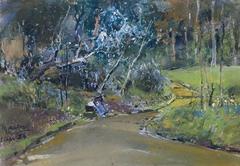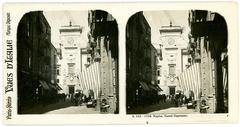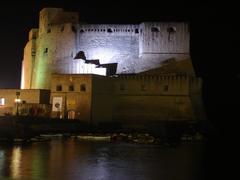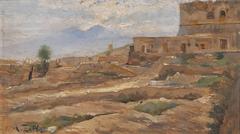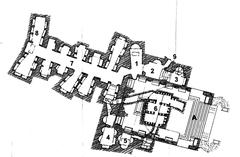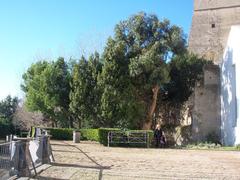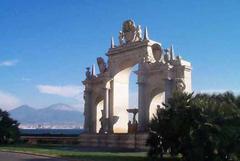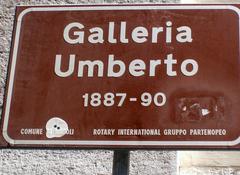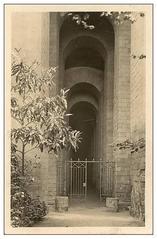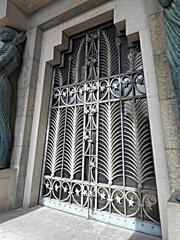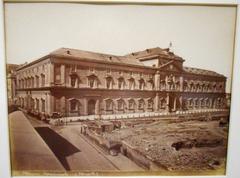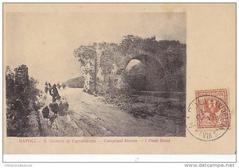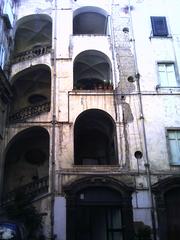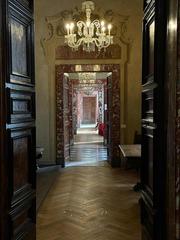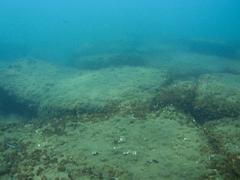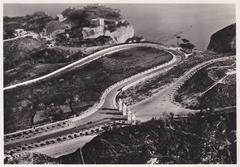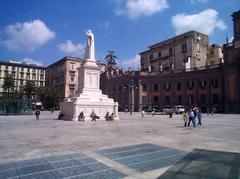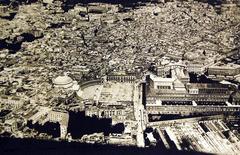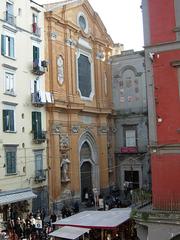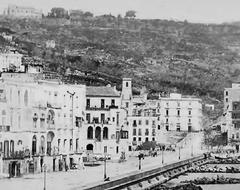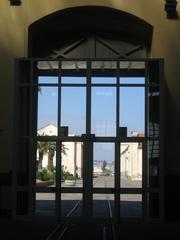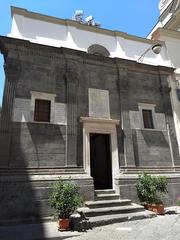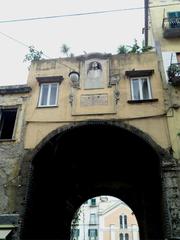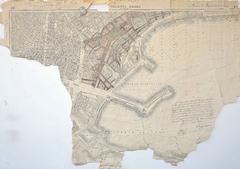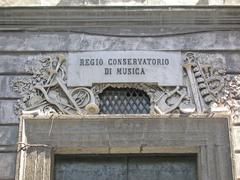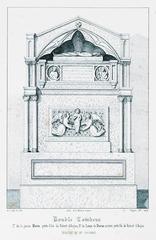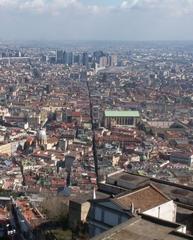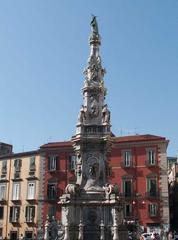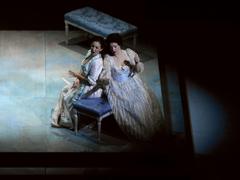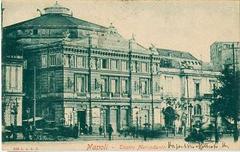
Villa Pignatelli Naples: Visiting Hours, Tickets, and Historical Site Guide
Date: 04/07/2025
Introduction: Villa Pignatelli’s History and Cultural Significance
Nestled along Naples’ scenic Riviera di Chiaia, Villa Pignatelli is a remarkable testament to 19th-century aristocratic grandeur and neoclassical architecture. Commissioned in 1826 by Sir Ferdinand Richard Acton and designed by Pietro Valente, the villa offers a unique window into the opulent lifestyles of Naples’ noble families. Over nearly two centuries, it has transitioned from a private residence—passing through the hands of the Rothschilds and Pignatellis—to a vibrant public museum and cultural hub. Its beautifully preserved interiors, lush English-style gardens, and the renowned Museo delle Carrozze (Carriage Museum) make Villa Pignatelli an essential destination for history buffs, art lovers, and travelers eager to delve into Naples’ cultural tapestry. This guide provides comprehensive visitor information, including up-to-date visiting hours, ticketing, accessibility, and expert travel tips, ensuring an enriching experience at one of Naples’ most treasured historical sites (opencampania.it; palazzorealedinapoli.org; Artsupp; Lonely Planet).
Table of Contents
- Introduction
- Origins and Early Construction
- Changes in Ownership and Aristocratic Life
- The Villa in the 20th Century
- Museum Era and Cultural Impact
- Neoclassical Architecture and Design
- Artistic Collections and Interior Highlights
- The Carriage Museum: Industrial Artistry
- The English Garden: Urban Oasis
- Visitor Information
- Visitor Experience: Highlights & Insights
- Frequently Asked Questions (FAQ)
- Conclusion
Origins and Early Construction
Villa Pignatelli is a prime example of Neapolitan neoclassical architecture. Commissioned in 1826 by Sir Ferdinand Richard Acton, son of John Francis Edward Acton (a prominent minister to King Ferdinand I of the Two Sicilies), the villa was designed by Pietro Valente to serve as a grand residence fronting the stylish Riviera di Chiaia (opencampania.it; turismo.ricercattiva.it). The monumental façade, marked by a Doric colonnade and Ionic order, exudes the elegance and symmetry characteristic of neoclassicism, while eclectic neo-Renaissance and neo-Baroque flourishes enrich the villa’s aesthetics (palazzorealedinapoli.org). The villa replaced an earlier Carafa family residence, adding further historical depth to the site (turismo.ricercattiva.it).
Changes in Ownership and Aristocratic Life
After Acton’s death in 1841, the villa was acquired by Carl Mayer von Rothschild of the eminent Rothschild banking family. The Rothschilds’ presence is still evident, including Carl’s “CR” monogram on the first floor (wikipedia). During their tenure, the villa emerged as a social and religious gathering place for Naples’ Jewish community.
In 1867, Diego Pignatelli Aragona y Cortes, Duke of Monteleón, purchased the estate, transforming it into a center of Neapolitan high society. The Pignatelli family hosted lavish balls and salons, with architect Guglielmo Bechi enhancing the interiors—including the marble staircase and neoclassical sculptures (thebestnaples.eu; kenzly.com).
The Villa in the 20th Century
During World War II, Villa Pignatelli served as a refuge for displaced families (headout.com). After the war, Princess Rosina Pignatelli, widow of Diego Pignatelli Aragona y Cortes, donated the villa to the Italian state in 1952, with the condition that its furnishings and collections remain intact (wikipedia; napolike.com). This donation, formalized in 1955, marked Villa Pignatelli’s transformation into a public museum (kenzly.com).
Museum Era and Cultural Impact
In 1975, Villa Pignatelli opened as the Museo Principe Diego Aragona Pignatelli Cortés and Carriage Museum (wikipedia). Its extensive collections—period furnishings, decorative arts, paintings, rare books, and carriages—present a vivid portrait of aristocratic life (whichmuseum.com). The villa’s elegant salons, Red Room, and billiard room, alongside the lush, 15,000-square-meter gardens, are highlights for visitors (thebestnaples.eu).
Neoclassical Architecture and Design
Villa Pignatelli is renowned for its neoclassical design, drawing inspiration from ancient Roman villas and the archaeological discoveries of Pompeii (World Tours Italy). The symmetrical layout, grand portico with Ionic columns, and seamless integration of indoor and outdoor spaces exemplify the neoclassical style. The villa’s English garden enhances its aesthetic appeal, reflecting 19th-century trends in landscape architecture (Artsupp).
Artistic Collections and Interior Highlights
Decorative Arts and Porcelain
Villa Pignatelli’s interiors preserve original 19th-century furnishings and an outstanding collection of porcelain from Capodimonte, Meissen, Limoges, and Vienna. Notable works include Capodimonte groups such as “The Rape of Proserpina,” a Gallant Scene, and “The Laundress,” reflecting superb craftsmanship (Artsupp).
Sculpture and Fine Art
The villa features sculptures by Giovanni De Martino, Domenico Guidi, Carlo Chelli, and Vincenzo Gemito, as well as paintings by Giovanni Filippo Criscuolo. These pieces showcase the artistic tastes of the villa’s residents and the artistic currents of their eras (Artsupp).
Library and Musical Heritage
A substantial library with around 2,000 volumes and over 4,000 classical and operatic music records testifies to the intellectual and cultural pursuits of the Pignatelli family (World Tours Italy).
The Carriage Museum: Industrial Artistry
The Museo delle Carrozze houses over 34 carriages and buggies from Italy, England, and France, spanning from the Bourbon era to the mid-20th century. These vehicles, along with harnesses and riding equipment, illuminate the evolution of transportation and aristocratic customs (Artsupp). This collection is among Italy’s most significant and is a must-see for history and technology enthusiasts (World Tours Italy).
The English Garden: Urban Oasis
Villa Pignatelli’s English-style garden, with winding paths, mature trees, statuary, and fountains, follows the 19th-century English landscape movement. It offers a tranquil retreat amid the urban bustle of Chiaia, serving as an important green space and a venue for cultural events (World Tours Italy).
Visitor Information
Visiting Hours
- Tuesday to Sunday: 9:00 AM – 7:00 PM (last admission 6:00 PM)
- Closed: Mondays and major holidays
- Always verify on the official website for seasonal changes or special closures.
Tickets and Pricing
- Standard Adult: €5–€10 (variation due to exhibitions or ticket combos)
- Reduced: €2–€5 (EU citizens 18–25, teachers, Artecard holders)
- Free: Children under 18, people with disabilities and their companions, Naples residents, first Sunday of the month (“Domenica al Museo”)
- Guided Tours: Available in Italian and English for an additional fee—book in advance (visitcampania.info; tickets-naples.com; headout.com)
Accessibility
- No architectural barriers; elevator provides access to all public floors.
- Restrooms and cloakroom are accessible.
- Contact the villa ahead of your visit for special assistance (visitcampania.info).
Getting There & Nearby Attractions
- Address: Riviera di Chiaia 200, 80121 Naples
- Public Transport: Bus lines 140, 151, N1, R7 stop at the entrance; nearest metro station under construction; Mergellina train station nearby (visitcampania.info).
- Parking: Paid public parking nearby is limited; public transport recommended.
- Nearby Sites: Villa Comunale, National Museum of Ceramics, Villa Floridiana, Palazzo delle Arti Napoli, Piazza dei Martiri (Lonely Planet; trek.zone).
Special Events and Tours
Villa Pignatelli hosts frequent concerts, exhibitions, and cultural events. The “Casa della fotografia” (House of Photography) is based here, with rotating photographic exhibitions. Check the official website for schedules and booking.
Visitor Experience: Highlights & Practical Insights
- Historic Interiors: Explore salons, private apartments, and the library with rare books and music collections.
- Carriage Museum: Admire 19th-century carriages and related artifacts in the former stables.
- Gardens: Enjoy the English-style landscaped park, ideal for relaxation or photography.
- House of Photography: Experience rotating exhibitions in contemporary spaces.
- Recommended Photography: The neoclassical façade, Salotto Verde, Carrara marble bathtub, and gardens are top photo spots.
Frequently Asked Questions (FAQ)
Q: What are the Villa Pignatelli visiting hours?
A: Tuesday–Sunday, 9:00 AM–7:00 PM (last admission 6:00 PM), closed Mondays.
Q: How much do tickets cost?
A: €5–€10 for adults, €2–€5 reduced, free for children under 18, residents, and certain categories.
Q: Is the villa wheelchair accessible?
A: Yes, with elevators and accessible restrooms.
Q: Are guided tours available?
A: Yes, in Italian and English—book in advance.
Q: Can I take photos inside?
A: Non-flash photography is allowed except during some temporary exhibitions.
Q: Is parking available?
A: Limited paid parking nearby; public transport is recommended.
Conclusion
Villa Pignatelli is a unique cultural landmark—offering a glimpse into Naples’ aristocratic past, a showcase of neoclassical architecture, and a venue for contemporary cultural events. Its collections, gardens, and central location make it an essential stop for anyone exploring Naples’ historical sites. For the latest visiting hours, ticketing, and event information, consult the official website, download the Audiala app, and follow Villa Pignatelli’s social media channels.
Visuals & Internal Links
Suggested Images:
- “Villa Pignatelli neoclassical façade in Naples”
- “Villa Pignatelli Royal Apartment interior”
- “19th-century ceremonial carriage at Villa Pignatelli Museum”
- “English garden at Villa Pignatelli in Naples”
Internal Links:
References and Further Reading
- Villa Pignatelli, OpenCampania
- Villa Pignatelli - Palazzo Reale di Napoli
- Villa Pignatelli Museum, Artsupp
- Villa Pignatelli Visiting Hours, TheBestNaples.eu
- Villa Pignatelli, Wikipedia
- Villa Pignatelli Visiting Hours and Tickets, Lonely Planet
- Villa Pignatelli Visitor Guide, VisitCampania.info
- Villa Pignatelli Museum Guide, World Tours Italy






